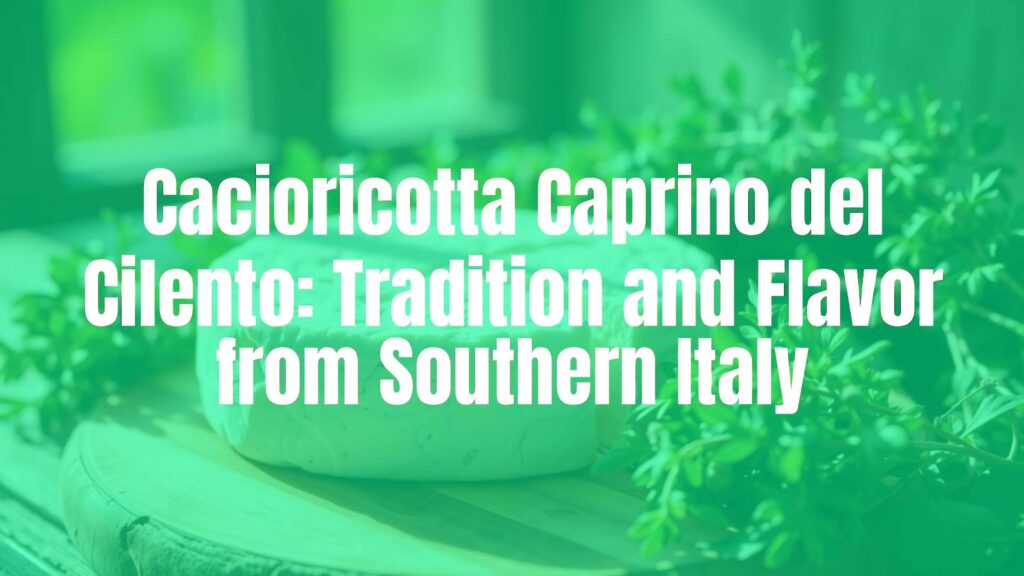Discovering Cacioricotta Caprino del Cilento
Cacioricotta Caprino del Cilento is a unique goat cheese that hails from the sun-kissed hills of Cilento, in the Campania region of southern Italy. Famed for its rustic character and deeply rooted artisanal heritage, this cheese offers a remarkable taste of its place of origin. Handcrafted using age-old methods, it stands out not only for its flavor but also for its cultural significance within the Cilento community.
Origins and Historical Perspective
The story of Cacioricotta Caprino del Cilento is intertwined with the pastoral traditions of Cilento. For generations, local shepherds have harnessed the milk of native Cilento goats, utilizing both their dairy and meat. The cheese’s name reflects its dual identity—cacio (cheese) and ricotta—hinting at the blend of traditional cheese and ricotta-making techniques unique to this area. This innovative approach emerged as a way to stretch resources and maximize flavors, ensuring that every drop of goat’s milk was used wisely during the peak spring and summer milking periods.
Production and Characteristics
Cacioricotta Caprino del Cilento begins with fresh, raw goat’s milk that is typically heated to a higher temperature than for most hard cheeses, reminiscent in part of ricotta preparation. The resulting curds are pressed into small molds, usually by hand, and the cheese is then salted and aged, often on wooden boards. The cheese develops a thin natural rind and a dense, semi-firm paste, which may range from snowy white to light straw in color depending on the length of aging.
Its flavor profile is distinctly tangy and aromatic, with nuances of herbs and wildflowers reflecting the diet of local goats. The texture can be slightly crumbly yet creamy, particularly in younger wheels, while matured cheeses develop a firmer and grater-friendly body.
Cultural Importance and Traditional Ways to Savor
More than just a cheese, Cacioricotta Caprino del Cilento represents the resilience and resourcefulness of rural communities in Cilento. It is a symbol of the region’s identity, celebrated in local fairs and used in age-old recipes. Goat herding and cheese-making are still an integral part of Cilento’s agricultural life, ensuring that traditions continue to be passed down.
Traditionally, residents enjoy this cheese sliced on rustic breads or as a topping for local pasta dishes such as cavatelli con cacioricotta, where it is grated over fresh tomato sauce. It is also served with fresh vegetables or simply alongside seasonal fruit, allowing the complexity of the cheese to shine.
Serving Suggestions and Pairings
For an authentic Cilento experience, try pairing Cacioricotta Caprino del Cilento with light red wines typical of southern Italy or a crisp local white. Its acidity and herbal undertones complement honey, ripe figs, or roasted peppers on a sharing platter. When aged, the cheese can be finely grated to enhance soups, baked pasta, or even savory pastries.
To appreciate its texture and aroma, serve the cheese at room temperature. If possible, source it from a reputable cheesemonger who imports directly from small Italian producers, as authenticity is key to unlocking its true flavors.
Regional Distinctiveness and Variations
While variations of cacioricotta exist in southern Italy, the “Caprino del Cilento” version distinguishes itself through the exclusive use of local goat milk and the distinctive Cilento microclimate. Its protected status as a traditional product (P.A.T.) helps preserve its production practices and supports the local economy.
Ultimately, Cacioricotta Caprino del Cilento is much more than a cheese; it’s a flavorful gateway into the customs, landscapes, and spirit of one of Italy’s most enchanting regions.

